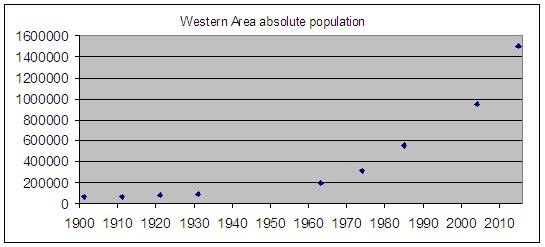November 1, 2017
Freetown Population Increase, 1901 -
2015The added data reveals a very sharp increase in the rate of growth of Freetown's population after about 1960, ie at the dawn of Independence. For the 52-year period between the 1963 and 2015 censuses, Freetown's annual growth rate was 4% and the population increased more than seven fold. For the 62-year period between the 1901 and 1963 censuses, Freetown's annual growth rate was 1.7% and the population increased less than three fold. For the 30-year period between the 1901 and 1931 censuses, Freetown's annual growth rate was 0.8% and the population increased by less than a third of its original value. Many modern-day economists view urban migration in third-world countries favourably, but the data indicates that the British colonial government certainly did not encourage it.

| 1901 |
1911 |
1921 |
1931 |
1963 |
1974 |
1985 |
2004 |
2015 |
|
| Western Area Total |
67782 |
68115 |
79561 |
86505 |
195023 |
316312 |
554243 |
947122 |
1500234 |
Note: Figures for 1901 to 1931 exclude Sherbro and Tassoh Island, which were then administratively under the Western Area. The figures for these years were taken from Sierra Leone Blue Books, various years, by kind courtesy of the Sierra Leone National Archives. There was also a census conducted in 1948, for which figures were unavailable. Figures for 1963 to 2015 are available from Statistics Sierra Leone.
The new data raises interesting questions: what caused this sharp increase in Freetown's growth rate around Independence? Was it simply the euphoria of Independence, somehow maintained 50 plus years later? Was it caused by active encouragement of migration by subsequent administrations? For what purpose? Conversely, if one takes the view that dual economic systems within a single national jurisdiction will naturally encourage migration, how were the British able to restrict urban migration so successfully during their administration? Was it through housing and land policy? Street trading policy? Vagrancy laws? Or some combination of all of these.